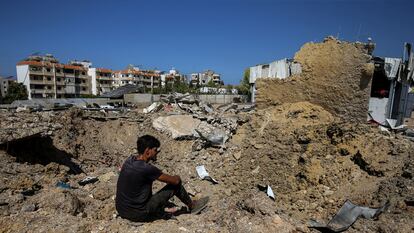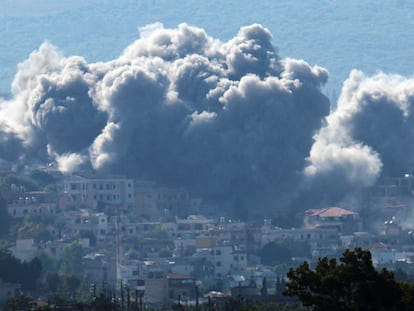Israel softens tone and agrees to negotiate US-led Lebanon ceasefire plan
Benjamin Netanyahu, who rejected the diplomatic initiative on Thursday, now recognizes Washington’s ‘indispensable’ role in advancing regional stability

Without alluding to possible pressure from Washington, Israel has softened it objection to a proposal for a 21-day ceasefire with Hezbollah in Lebanon. On Thursday, Israel had roundly opposed the plan — which is backed by the United States and France —, but on Friday, the government of Prime Minister Benjamin Netanyahu said Israeli authorities were discussing the initiative.
“Israel shares the aims of the U.S.-led initiative of enabling people along our northern border to return safely and securely to their homes,” the statement from Netanyahu’s office read. “Israel appreciates the U.S. efforts in this regard because the U.S. role is indispensable in advancing stability and security in the region.”
The statement refers to the 60,000 Israelis evacuated from around the border with Lebanon, who have been living for months in hotels, rented houses or hosted by relatives in different regions of the country. It comes after Israeli Defense Forces (IDF) intercepted a ballistic missile fired from Yemen Friday morning, when sirens were activated in Tel Aviv.
The change in tone coincides with Netanyahu’s arrival in New York, where he will address the United Nations General Assembly. Pro-Palestine rallies were held outside his hotel ahead of his speech on Friday. The conciliatory statement is in stark contrast to his comments on Thursday, when he said that he had not responded to the ceasefire proposal and had instructed the IDF to “continue fighting with full force.”
Friday’s statement reveals that while Netanyahu was publicly slamming the diplomatic initiative, his aides were meeting on Thursday to push it forward. “Earlier this week, the United States shared with Israel its intention to put forward, together with other international and regional partners, a ceasefire proposal in Lebanon. Our teams met [on Thursday, September 26] to discuss the U.S. initiative and how we can advance the shared goal of returning people safely to their homes. We will continue those discussions in the coming days,” the statement from Netanyahu’s office added.
Both the U.S. and France were unwilling to abandon the proposal, despite the difficulty involved in deescalating the tensions. White House security spokesperson John Kirby said that Israel had been “fully informed and fully aware of every word” of the truce proposal. For his part, French President Emmanuel Macron said: “I think it would be a mistake for the [Israeli] prime minister to refuse it because he would have to take responsibility for a regional escalation far beyond what anyone could control.”
The statement from Netanyahu’s office says that Israel wanted to clarify its position on the ceasefire proposal due to the “vast amount of misinformation” that had been spread. This appears to be an allusion to the international uproar that was sparked after Israel dismissed the plan while hinting the IDF was preparing for a possible ground invasion of Lebanon.
Indeed, the IDF announced that thousands of troops from Gaza were being deployed to the north and that it was launching airstrikes against Lebanon to prepare the ground for a “possible entry” into the neighboring country. Hezbollah, for its part, continues to fire dozens of rockets at different regions of Israel, most of which are intercepted after triggering warning sirens.
A ground incursion into Lebanese territory would greatly complicate the plans for a ceasefire and raise many questions. Once Israeli troops enter Lebanon: how and when will they leave? The IDF entered Gaza on October 27, three weeks after the war began. Almost a year later, with more than 41,000 dead in Gaza, there is no sign that Israel has any plans to withdraw from the territory.
Meanwhile, the Houthi militia has launched a new long-range missile at Israel. This time, unlike in previous occasions, Israeli anti-aircraft defenses — specifically the Arrow system — intercepted the missile before it reached Israeli airspace, the army reported in a statement. The target, as shown by the alarm map activated by authorities, was an area near Tel Aviv, a large city on the Mediterranean coast. No victims were reported, and operations at Ben Gurion Airport were not affected.
Israel is defended by a multi-tiered air defense system. The lowest tier, in terms of altitude, is the Iron Dome, which has been in operation since 2011. It intercepts short-range rockets and artillery, such as those frequently fired by Hamas and Islamic Jihad from Gaza, or Hezbollah from southern Lebanon. The mid-tier is the so-called David’s Sling, which has been in operation since 2017 and is designed to stop ballistic and cruise missiles, as well as medium- and long-range rockets. The top tier is the Arrow system, which has also been in operation since 2017. It intercepts missiles that fly outside the atmosphere.
Sign up for our weekly newsletter to get more English-language news coverage from EL PAÍS USA Edition
Tu suscripción se está usando en otro dispositivo
¿Quieres añadir otro usuario a tu suscripción?
Si continúas leyendo en este dispositivo, no se podrá leer en el otro.
FlechaTu suscripción se está usando en otro dispositivo y solo puedes acceder a EL PAÍS desde un dispositivo a la vez.
Si quieres compartir tu cuenta, cambia tu suscripción a la modalidad Premium, así podrás añadir otro usuario. Cada uno accederá con su propia cuenta de email, lo que os permitirá personalizar vuestra experiencia en EL PAÍS.
¿Tienes una suscripción de empresa? Accede aquí para contratar más cuentas.
En el caso de no saber quién está usando tu cuenta, te recomendamos cambiar tu contraseña aquí.
Si decides continuar compartiendo tu cuenta, este mensaje se mostrará en tu dispositivo y en el de la otra persona que está usando tu cuenta de forma indefinida, afectando a tu experiencia de lectura. Puedes consultar aquí los términos y condiciones de la suscripción digital.
More information
Archived In
Últimas noticias
Most viewed
- Alain Aspect, Nobel laureate in physics: ‘Einstein was so smart that he would have had to recognize quantum entanglement’
- David King, chemist: ‘There are scientists studying how to cool the planet; nobody should stop these experiments from happening’
- Mexico completes its trade shift with the entry into force of tariffs on China and countries without trade agreements
- Reinhard Genzel, Nobel laureate in physics: ‘One-minute videos will never give you the truth’
- Oona Chaplin: ‘I told James Cameron that I was living in a treehouse and starting a permaculture project with a friend’











































